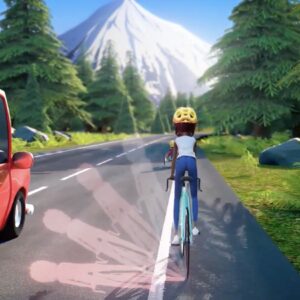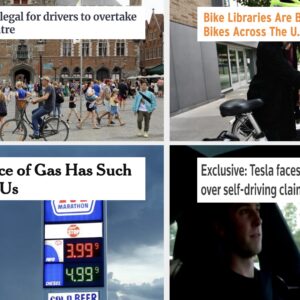[Updated 6/15/07, 1:15pm]
A bill that seemed to come out of nowhere (I didn’t know about it until I read the Statesman Journal this morning) and that started out having nothing to do with bicycle safety, has passed the House, and is set to become Oregon’s first safe passing legislation that specifically protects bicyclists.
Senate Bill 108, will amend the Oregon Revised Statute that deals with following too closely (ORS 811.485) to include several stipulations about how a motor vehicle is required to pass a bicyclist. The bill avoids the three-foot passing distance that has been adopted by other states and instead defines a ‘safe distance’ as,
“…a distance that is sufficient to prevent contact with the person operating the bicycle if the person were to fall off the bicycle into the driver’s lane of traffic.”
According to the bill, a motor vehicle,
“…must only pass a person operating a bicycle by driving to the left of the bicycle at a safe distance and returning to the lane of travel once the motor vehicle is safely clear of the overtaken bicycle…and, may drive to the left of the center of a roadway to pass a person operating a bicycle proceeding in the same direction only if the roadway to the left of the center is unobstructed for a sufficient distance to permit the driver to pass the person operating the bicycle safely and avoid interference with oncoming traffic.”
The bill also lays out some key exceptions,
“…does not apply to a driver operating a motor vehicle:
(A) In a lane that is separate from and adjacent to a designated bicycle lane;
(B) At a speed not greater than 35 miles per hour; or*
(C) When the driver is passing a person operating a bicycle on the person’s right side and the person operating the bicycle is
turning left.”
*Exception (B) is noteworthy because it makes this a rural road bill. City and local residential streets would not be covered under this legislation.
The bill makes an infraction of these laws a Class B traffic violation, punishable by a $360 fine. According to the Statesman Journal newspaper, Senator Floyd Prozanski (D-Eugene) — a close friend of Jane Higdon, who was struck and killed by a passing truck one year ago — worked with other lawmakers to pass the bill.
The bill has passed the Senate and the House, and now it goes back to the Senate for approval of amendments before being signed into law.






Thanks for reading.
BikePortland has served this community with independent community journalism since 2005. We rely on subscriptions from readers like you to survive. Your financial support is vital in keeping this valuable resource alive and well.
Please subscribe today to strengthen and expand our work.
The bill gives us more than 3 feet. From the top of my head, when I\’m sitting up, down to the pavement, is more than 5 feet.
Wish it had been in effect on the Pioneer Century, when the horse-trailer towing pickup was deliberately passing close and fast, causing a rider in front of me to fall over; fortunately the other way.
It would be nice to see information about this new law show up in the mail with car registration renewals. I got mine recently and it had a leaflet about the (relatively) new crosswalk laws.
I like the wording of this bill but what are its chances of becoming law? Before I get my hopes up I want to understand the rest of that legislative process necessary to turn these words into law. The $360 fine is not much of an impediment but maybe the distinction as a Class B violation will deter more folks. I think that the real key to the problem is education and ongoing communication. The entitlement assumption built into the car culture needs to be addressed.
sorry I didn\’t make the process clear Jim. I\’ve edited the post. right now, it will most likely become law. the last step are Senate approval of amendments made in the House. Once that happens (which is likely), the bill will be signed into law by the Gov.
So here\’s a question: if this becomes a law, how does it get enforced? Am I right in assuming that a police officer would have to see this and judge the distance with his own eyeballs? I guess we could always file a report if we got a license plate number, but without a third-party witness, it doesn\’t sound like it stands a substantial chance of being upheld.
Enforcement on buses should be interesting.
I can\’t wait to see the zig-zagging of cars on Hawthorne and Belmont.
I am all for this, but I think an exact number like 3 feet will be easier for drivers to understand and follow than the specified formula. Plus, there is no way cars will give us a 5 foot buffer.
While this would be another good step taken, I do not see too many tickets being issued because of it. In Washington County (according to the Sheriff) all infractions and misdemeanors must be observed by a deputy. The courts no longer have the funding to handle a citizen arrest no matter how many witnesses you have.
It\’s so ambiguous…\”a distance that is sufficient…\” Does a 6 foot tall rider rate more \”sufficient distance\” than a 5 foot tall rider?
And \”…fall off the bicycle…\” doesn\’t necessarily mean tip over at a 90 degree angle to the full extension of height. Or does it???
I\’m all for safe clearance when being passed, but I\’ve rarely seen a cyclist \”fall over\” while riding.
\”Does a 6 foot tall rider rate more \”sufficient distance\” than a 5 foot tall rider?\”
IMO, yes – and by extension, no one should pass within 10\’ or less of a tallbike. We do the same thing with motor vehicles, though I don\’t know if that\’s been codified into law. Most cars won\’t turn right inside a turning semi, for instance.
Then again, most bikes can\’t destroy a car by coming in contact with it, so I suppose the semi has \”threat\” value.
I\’m confused by the double negatives in the exceptions section:
“…does not apply to a driver operating a motor vehicle:
… (B) At a speed not greater than 35 miles per hour;
If it doesn\’t apply when not going faster than 35, does that means that the law only applies to vehicles going FASTER than 35 mph?
I hope I\’m just misreading the language because if the law doesn\’t apply on local streets (usually 25 mph) then what\’s the point?
Andrew,
Yes. you read that right. I\’ve updated the post to make that more clear. I guess this is what you\’d call a compromise bill. baby steps. baby steps.
Thanks for clearing that one up, Jonathan. It did draw my attention to the next section:
\”When the driver is passing a person operating a bicycle on the person’s right side and the person operating the bicycle is turning left.\”
I can see this making sense if the cyclist is in a separate turn lane, as when the law doesn\’t apply if the cyclist is in a bike lane. But, this section appears to me to be saying if the cyclist is in the extreme left side of the traffic lane, signalling a left turn, I can pass as closely as I want in the same lane.
This really appears to be badly written.
Jonathan, I think this bill did get mentioned here earlier, in a blog comment by Scott Bricker — there was another bill that died, but elements of it were gut-and-stuffed into SB 108.
you should be my editor Helen! you\’re right. he did mention it. that other \”bill that died\” was SB 299.